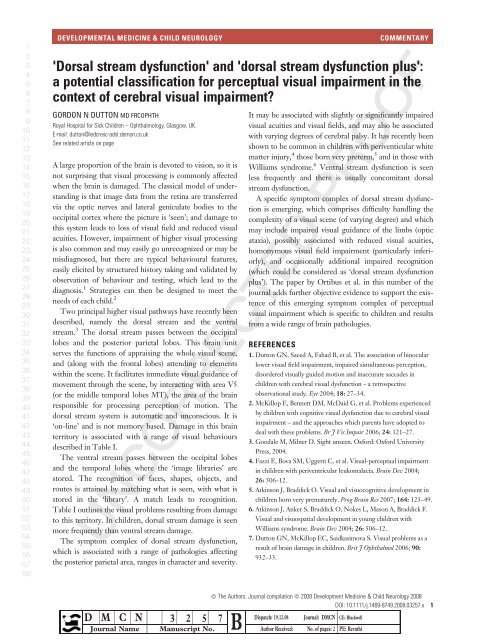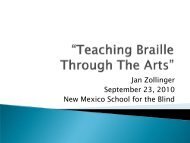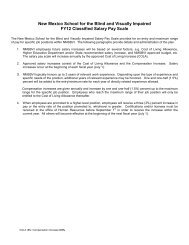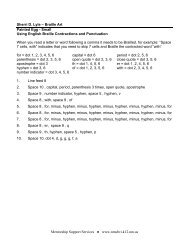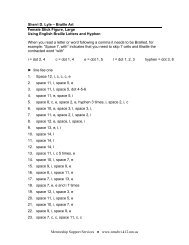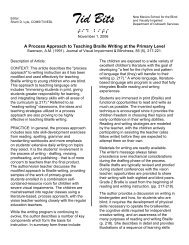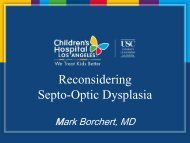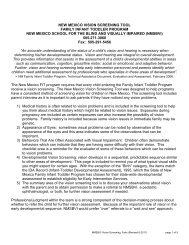'Dorsal stream dysfunction' and
'Dorsal stream dysfunction' and
'Dorsal stream dysfunction' and
Create successful ePaper yourself
Turn your PDF publications into a flip-book with our unique Google optimized e-Paper software.
1<br />
2<br />
3<br />
4<br />
5<br />
6<br />
7<br />
8<br />
9<br />
10<br />
11<br />
12<br />
13<br />
14<br />
15<br />
16<br />
17<br />
18<br />
19<br />
20<br />
21<br />
22<br />
23<br />
24<br />
25<br />
26<br />
27<br />
28<br />
29<br />
30<br />
31<br />
32<br />
33<br />
34<br />
35<br />
36<br />
37<br />
38<br />
39<br />
40<br />
41<br />
42<br />
43<br />
44<br />
45<br />
46<br />
47<br />
48<br />
49<br />
50<br />
51<br />
52<br />
53<br />
54<br />
55<br />
56<br />
57<br />
58<br />
DEVELOPMENTAL MEDICINE & CHILD NEUROLOGY<br />
<strong>'Dorsal</strong> <strong>stream</strong> <strong>dysfunction'</strong> <strong>and</strong> 'dorsal <strong>stream</strong> dysfunction plus':<br />
a potential classification for perceptual visual impairment in the<br />
context of cerebral visual impairment?<br />
GORDON N DUTTON MD FRCOPHTH<br />
Royal Hospital for Sick Children – Ophthalmology, Glasgow, UK.<br />
E-mail: dutton@ledcresc-adsl.demon.co.uk<br />
See related article on page<br />
A large proportion of the brain is devoted to vision, so it is<br />
not surprising that visual processing is commonly affected<br />
when the brain is damaged. The classical model of underst<strong>and</strong>ing<br />
is that image data from the retina are transferred<br />
via the optic nerves <strong>and</strong> lateral geniculate bodies to the<br />
occipital cortex where the picture is ‘seen’; <strong>and</strong> damage to<br />
this system leads to loss of visual field <strong>and</strong> reduced visual<br />
acuities. However, impairment of higher visual processing<br />
is also common <strong>and</strong> may easily go unrecognized or may be<br />
misdiagnosed, but there are typical behavioural features,<br />
easily elicited by structured history taking <strong>and</strong> validated by<br />
observation of behaviour <strong>and</strong> testing, which lead to the<br />
diagnosis. 1 Strategies can then be designed to meet the<br />
needs of each child. 2<br />
Two principal higher visual pathways have recently been<br />
described, namely the dorsal <strong>stream</strong> <strong>and</strong> the ventral<br />
<strong>stream</strong>. 3 The dorsal <strong>stream</strong> passes between the occipital<br />
lobes <strong>and</strong> the posterior parietal lobes. This brain unit<br />
serves the functions of appraising the whole visual scene,<br />
<strong>and</strong> (along with the frontal lobes) attending to elements<br />
within the scene. It facilitates immediate visual guidance of<br />
movement through the scene, by interacting with area V5<br />
(or the middle temporal lobes MT), the area of the brain<br />
responsible for processing perception of motion. The<br />
dorsal <strong>stream</strong> system is automatic <strong>and</strong> unconscious. It is<br />
‘on-line’ <strong>and</strong> is not memory based. Damage in this brain<br />
territory is associated with a range of visual behaviours<br />
described in Table I.<br />
The ventral <strong>stream</strong> passes between the occipital lobes<br />
<strong>and</strong> the temporal lobes where the ‘image libraries’ are<br />
stored. The recognition of faces, shapes, objects, <strong>and</strong><br />
routes is attained by matching what is seen, with what is<br />
stored in the ‘library’. A match leads to recognition.<br />
Table I outlines the visual problems resulting from damage<br />
to this territory. In children, dorsal <strong>stream</strong> damage is seen<br />
more frequently than ventral <strong>stream</strong> damage.<br />
The symptom complex of dorsal <strong>stream</strong> dysfunction,<br />
which is associated with a range of pathologies affecting<br />
the posterior parietal area, ranges in character <strong>and</strong> severity.<br />
It may be associated with slightly or significantly impaired<br />
visual acuities <strong>and</strong> visual fields, <strong>and</strong> may also be associated<br />
with varying degrees of cerebral palsy. It has recently been<br />
shown to be common in children with periventicular white<br />
matter injury, 4 those born very preterm, 5 <strong>and</strong> in those with<br />
Williams syndrome. 6 Ventral <strong>stream</strong> dysfunction is seen<br />
less frequently <strong>and</strong> there is usually concomitant dorsal<br />
<strong>stream</strong> dysfunction.<br />
A specific symptom complex of dorsal <strong>stream</strong> dysfunction<br />
is emerging, which comprises difficulty h<strong>and</strong>ling the<br />
complexity of a visual scene (of varying degree) <strong>and</strong> which<br />
may include impaired visual guidance of the limbs (optic<br />
ataxia), possibly associated with reduced visual acuities,<br />
homonymous visual field impairment (particularly inferiorly),<br />
<strong>and</strong> occasionally additional impaired recognition<br />
(which could be considered as ‘dorsal <strong>stream</strong> dysfunction<br />
plus’). The paper by Ortibus et al. in this number of the<br />
journal adds further objective evidence to support the existence<br />
of this emerging symptom complex of perceptual<br />
visual impairment which is specific to children <strong>and</strong> results<br />
from a wide range of brain pathologies.<br />
REFERENCES<br />
1. Dutton GN, Saeed A, Fahad B, et al. The association of binocular<br />
lower visual field impairment, impaired simultaneous perception,<br />
disordered visually guided motion <strong>and</strong> inaccurate saccades in<br />
children with cerebral visual dysfunction – a retrospective<br />
observational study. Eye 2004; 18: 27–34.<br />
2. McKillop E, Bennett DM, McDaid G, et al. Problems experienced<br />
by children with cognitive visual dysfunction due to cerebral visual<br />
impairment – <strong>and</strong> the approaches which parents have adopted to<br />
deal with these problems. Br J Vis Impair 2006; 24: 121–27.<br />
3. Goodale M, Milner D. Sight unseen. Oxford: Oxford University<br />
Press, 2004.<br />
4. Fazzi E, Bova SM, Uggetti C, et al. Visual-perceptual impairment<br />
in children with periventricular leukomalacia. Brain Dev 2004;<br />
26: 506–12.<br />
5. Atkinson J, Braddick O. Visual <strong>and</strong> visuocognitive development in<br />
children born very prematurely. Prog Brain Res 2007; 164: 123–49.<br />
6. Atkinson J, Anker S, Braddick O, Nokes L, Mason A, Braddick F.<br />
Visual <strong>and</strong> visuospatial development in young children with<br />
Williams syndrome. Brain Dev 2004; 26: 506–12.<br />
7. Dutton GN, McKillop EC, Saidkasimova S. Visual problems as a<br />
result of brain damage in children. Brit J Ophthalmol 2006; 90:<br />
932–33.<br />
COMMENTARY<br />
D M C N 3 2 5 7<br />
B<br />
ª The Authors. Journal compilation ª 2008 Development Medicine & Child Neurology 2008<br />
DOI: 10.1111/j.1469-8749.2008.03257.x 1<br />
Dispatch: 19.12.08 Journal: DMCN CE: Blackwell<br />
Journal Name Manuscript No. Author Received: No. of pages: 2 PE: Revathi
1<br />
2<br />
3<br />
4<br />
5<br />
6<br />
7<br />
8<br />
9<br />
10<br />
11<br />
12<br />
13<br />
14<br />
15<br />
16<br />
17<br />
18<br />
19<br />
20<br />
21<br />
22<br />
23<br />
24<br />
25<br />
26<br />
27<br />
28<br />
29<br />
30<br />
31<br />
32<br />
33<br />
34<br />
35<br />
36<br />
37<br />
38<br />
39<br />
40<br />
41<br />
42<br />
43<br />
44<br />
45<br />
46<br />
47<br />
48<br />
49<br />
50<br />
51<br />
52<br />
53<br />
54<br />
55<br />
56<br />
57<br />
58<br />
Table I: Typical behavioural features of perceptual visual impairment in children due to dorsal <strong>and</strong> ventral <strong>stream</strong> dysfunction, <strong>and</strong> an outline of<br />
possible strategies to help. Modified from Dutton et al. 7<br />
Features<br />
Dorsal <strong>stream</strong> dysfunction<br />
Difficulty h<strong>and</strong>ling the complexity of<br />
the visual scene causes problems:<br />
Finding a toy on a patterned background<br />
Finding a toy in a toy-box<br />
Finding clothes in a drawer or in a pile<br />
Seeing a distant object (as there is more to see)<br />
Finding someone in a group<br />
Getting lost in crowded places<br />
Distress in crowded locations<br />
Reading<br />
Difficulty with visual guidance of<br />
movement causes problems:<br />
With inaccurate reach <strong>and</strong> grasp<br />
Difficulty walking over uneven ground <strong>and</strong> steps<br />
despite viewing directly <strong>and</strong> good motor function<br />
Difficulty ‘dual tasking’ causes problems:<br />
Bumping into obstacles when talking while walking<br />
Marked frustration when distracted from task<br />
Ventral <strong>stream</strong> dysfunction<br />
Difficulty with recognition causes problems:<br />
Recognizing people <strong>and</strong> knowing who is unknown<br />
Underst<strong>and</strong>ing the language of facial expression<br />
Recognizing shapes <strong>and</strong> objects <strong>and</strong> their alignment<br />
Difficulties with orientation cause problems:<br />
Navigating inside the house<br />
Navigating outside<br />
Strategies<br />
Use plain bed spreads <strong>and</strong> carpets<br />
Store toys separately (with linear storage)<br />
Store clothes separately in compartments<br />
Get close. Reduce clutter around blackboard<br />
Share screen of a digital ⁄ video camera<br />
Wear bright clothes, wave, <strong>and</strong> speak<br />
Adopt buddy or similar strategy for playground<br />
Training in seeking <strong>and</strong> recalling l<strong>and</strong>marks<br />
Arrive at parties early<br />
Go shopping when quiet<br />
Enlarge <strong>and</strong> space out text. Mask surrounding text<br />
Wear full spectacle correction for hypermetropia<br />
to gain magnification. Use magnifiers<br />
Use tactile guidance with other h<strong>and</strong> as part of occupational<br />
therapy<br />
Reach beyond <strong>and</strong> gather up<br />
Provide tactile guidance to the height of the ground ahead,<br />
such as using a toy pram or allow to hold on to clothes<br />
of an accompanying person (while pulling down)<br />
Limit conversation when walking<br />
Limit background clutter <strong>and</strong> activity<br />
Family <strong>and</strong> friends introduce themselves <strong>and</strong> wear identifiers<br />
Language is used to explain emotions<br />
Include training in tactile recognition using blind methods<br />
Use colour coding for doors<br />
Put footprints on the floor to follow<br />
Create songs <strong>and</strong> poems for routes<br />
2 Developmental Medicine & Child Neurology 2008
USING E-ANNOTATION TOOLS FOR ELECTRONIC PROOF CORRECTION<br />
Required Software<br />
Adobe Acrobat Professional or Acrobat Reader (version 7.0 or above) is required to e-annotate PDFs.<br />
Acrobat 8 Reader is a free download: http://www.adobe.com/products/acrobat/readstep2.html<br />
Once you have Acrobat Reader 8 on your PC <strong>and</strong> open the proof, you will see the Commenting Toolbar (if it<br />
does not appear automatically go to Tools>Commenting>Commenting Toolbar). The Commenting Toolbar<br />
looks like this:<br />
Note Tool — For making notes at specific points in the text<br />
Marks a point on the paper where a note or question needs to be addressed.<br />
How to use it:<br />
1. Right click into area of either inserted<br />
text or relevance to note<br />
2. Select Add Note <strong>and</strong> a yellow speech<br />
bubble symbol <strong>and</strong> text box will appear<br />
3. Type comment into the text box<br />
4. Click the X in the top right h<strong>and</strong> corner<br />
of the note box to close.<br />
Replacement text tool — For deleting one word/section of text <strong>and</strong> replacing it<br />
Strikes red line through text <strong>and</strong> opens up a replacement text box.<br />
How to use it:<br />
1. Select cursor from toolbar<br />
2. Highlight word or sentence<br />
3. Right click<br />
4. Select Replace Text (Comment) option<br />
5. Type replacement text in blue box<br />
6. Click outside of the blue box to close<br />
Cross out text tool — For deleting text when there is nothing to replace selection<br />
Strikes through text in a red line.<br />
How to use it:<br />
1. Select cursor from toolbar<br />
2. Highlight word or sentence<br />
3. Right click<br />
4. Select Cross Out Text<br />
Approved tool — For approving a proof <strong>and</strong> that no corrections at all are required.<br />
Page 1 of 2<br />
How to use it:<br />
1. Click on the Stamp Tool in the toolbar<br />
2. Select the Approved rubber stamp from<br />
the ‘st<strong>and</strong>ard business’ selection<br />
3. Click on the text where you want to rubber<br />
stamp to appear (usually first page)


